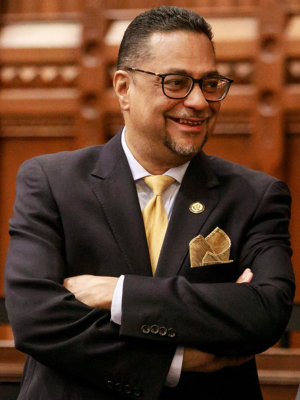Universal Free School Meals for a Healthier & Stronger Future
By Rep. Geraldo Reyes (CT)

Rep. Geraldo Reyes (CT)
Download the 2025 Spring Edition here.
Food insecurity among students remains an urgent issue in America, disproportionately impacting Hispanic communities. While federal programs like the National School Lunch Program (NSLP) and the School Breakfast Program (SBP) provide free or reduced-price meals to low-income students, too many children are still slipping through the cracks. Families earning just above the eligibility threshold often struggle to afford school meals, while the stigma associated with free lunches discourages many students from participating. Bureaucratic barriers—such as complex applications, language obstacles, and concerns about immigration status—further prevent access.
The solution is clear: universal free school meals. By ensuring that every child, regardless of income, receives free breakfast and lunch at school, we can eliminate food insecurity, improve academic performance, and promote health equity. It is time to move beyond outdated, means-tested meal programs and adopt a system that works for all students.
Hispanic communities faces food insecurity at twice the rate of white households, according to a 2022 U.S. Department of Agriculture study. Many working-class families earn just enough to be ineligible for free or reduced-price meals but still struggle to afford school lunch. These families are left with an impossible choice: pay for meals or risk their child going hungry.
States like California, Colorado, Maine, and Minnesota have already shown that universal free meal programs work. These states have increased student participation, improved academic outcomes, and reduced administrative burdens on schools. My state of Connecticut was previously able to offer free meals to all students due to waivers from the U.S. Department of Agriculture, which expired in the Summer of 2024. The state legislature stepped in to continue this program, but the future of federal funding is uncertain. Nevertheless, I’ve kept advocating to keep advancing bills that tackles food insecurity in our communities.
Most recently, the Finance, Revenue and Bonding Committee held a public hearing on House Bill 7273, which would impose a tax of $.02 per ounce on sweetened beverages, syrups and powders, with revenue earmarked to fund a universal free school meals program for all public school students.
The Case for Universal Free School Meals
Universal free meals eliminate the problems of the current system while benefiting all students and families. This approach:
- Ensures every student gets the nutrition they need without the need for applications or income verification.
- Eliminates stigma, so no child has to feel embarrassed about receiving a free meal.
- Increases participation rates, helping students focus, learn, and perform better in school.
- Reduces administrative costs by allowing schools to redirect resources toward education instead of meal program paperwork.
- Ends meal debt, so families no longer face financial penalties for struggling to afford school lunch.
- Universal free school meals are not just a social policy—they are an economic and educational necessity.
A Smart Investment
Detractors to these initiatives argue that universal meals are too costly. but the reality is that the long-term savings far outweigh the upfront investment. A report from the National Library of Medicine highlights how eliminating administrative costs, increasing student participation, and improving public health can offset much of the expense.
Congress has already introduced the Universal School Meal Program Act to expand federal funding for free school meals. Supporting and passing this legislation is a necessary step toward ensuring that no child goes hungry at school and should be a priority for Congress. Additionally, states and local governments can leverage federal grants and partner with local food suppliers to make high-quality, nutritious meals available to all students.
Beyond Access: Prioritizing Nutrition and Inclusion
Ensuring access to free meals is just the first step. Schools must also prioritize:
- Nutritional quality, by working with local farms and food suppliers to serve fresh, balanced meals.
- Cultural relevance, by incorporating diverse meal options that reflect students’ backgrounds and dietary needs.
- Infrastructure improvements, by upgrading kitchen facilities and hiring additional staff to accommodate increased meal participation. As leaders, we must work with our local, state and federal partners to ensure every child has the nutrition they need to learn, grow, and thrive. This is not a partisan issue. It’s about doing what is right for our children, our families, and our future. Our students deserve nothing less.
